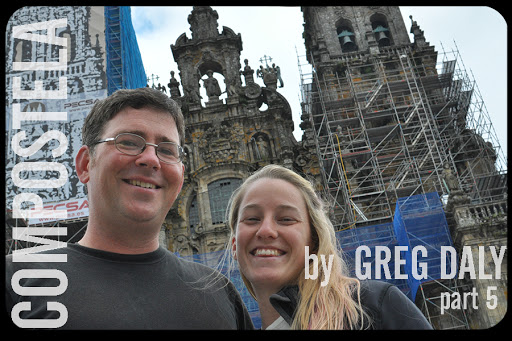(Journal Entry One, Two, Three, Four, Five)
A couple of hours after leaving O’Cebreiro we stopped for lunch, soon to be joined by the Canada-based Irish couple Tom and Frances, with the girls following shortly afterwards. Together we set off for Fillobal, one of the 30,000 tiny hamlets that dot the Galician countryside. A storm reminiscent of my first week on the Camino started as we were settling into our little albergue. Aside from a few droplets at lunch time, this was the first rain I’d seen since before I’d reached Santo Domingo more than two weeks earlier.
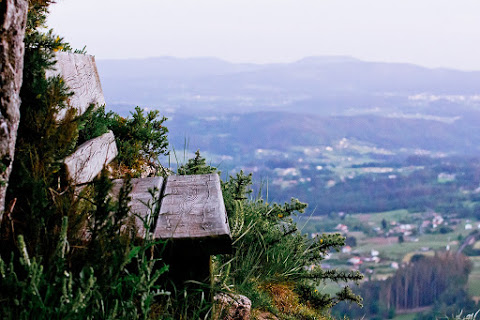
OndasDeRuida
We’d see a lot more before the Camino was over: the Galician countryside is lush, grassy, and forested, and isn’t that green by accident.
The rain staved off the next day as we wound our way through Triacastela, wooded hills, and a succession of hamlets, with the heavens only opening as we reached the outskirts of Sarria, our target for the day. Despite the weather the town was abuzz with life, the locals strolling among market stalls or preparing the streets with petals and pine needles for the following day’s Corpus Christi procession. By then we’d be on the road again, however, so Steve, Suus, and I made our way down to the nearest church for the vigil Mass instead. Chad and Mason, two Colorado brothers we’d first met in Carrión were there, and Chris and Miriam, a couple from North Carolina I’d originally met the day after meeting the brothers, and not seen since León.
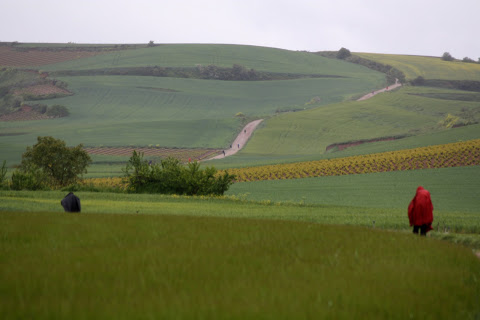
Hans Jacob Weinz CC
As we set out on Sunday, it was clear that the Camino had changed. Little more than a hundred kilometres from Santiago, Sarria is the starting point for just over a third of those following the French route – the Camino Francés – to Santiago. The path out of town was crowded with unfamiliar figures, all conspicuously clean and fresh, their packs tiny and their boots shiny and new, unlike ours which had been reduced to a battered, broken beige.
It was hard not to be snooty about the newcomers, many of whom were sending their bags ahead rather than carrying them, staying in hotels as a matter of course, and doing the bare minimum necessary to receive their Compostela certificate in Santiago. It seemed ridiculous to us that so many people could basically turn up at the last minute, stroll to Santiago, and get the same affirmation as pilgrims who’d spent five weeks or more trekking there.
"I feel as though there’s something in the Bible about this kind of thing," remarked Chad, when I mentioned it to him a couple of days later. "Yes, the parable of the workers in the vineyard," I conceded, "I know. And that’s it, really: other people’s pilgrimages are none of our business. Even if the way somebody else gets to Santiago doesn’t sit right with me, that’s my problem, not theirs. We have our own Caminos to walk, and should just concentrate on them."
The road to Portomarin wasn’t particularly long, but I found it tough, with the afternoon sun taking a heavy toll and with the landscape doing little to urge me on. If earlier on the Camino the sight of a steeple meant that there was a village ahead, with somewhere to rest, and refill water bottles, and have a coffee or talk to people, here it simply meant that there was another picturesque hamlet ahead, with little or no reason to stop.
I felt ill by the time I crossed the bridge and climbed the steps to Portomarin, and worse when I set out again the following morning, but after a break two hours into my walk I picked up a bit and made slightly better time, chatting as I went with an Irish girl who was walking with her family, including relations from America. This, I suddenly realised, was a Camino experience that long-distance pilgrims like myself couldn’t share: if you want to travel with your family, and make sure you’re together at the end of the day, long distances are impractical and booking ahead
en masse is almost obligatory. Faced with such practical challenges, Camino tour companies provide the perfect answer.
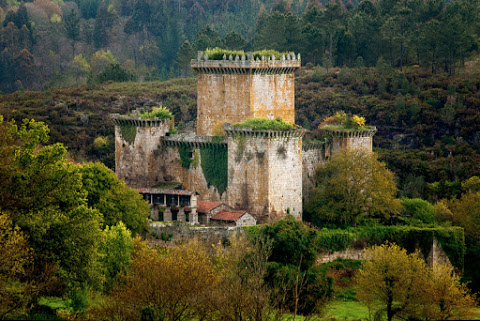
Luscofusco CC
It hadn’t rained since Sarria, but as I passed through Palas de Rei it was clear a storm was brewing, and I reached the beautiful village of San Xulian, thinking it to have been our agreed destination for the day, to a constant soundtrack of thunder. The others weren’t there, though, and it became clear that they were just a kilometre or so ahead at Pontecampaña. I was about to leave when the storm broke, with hailstones the size of marbles being followed by a downpour. I waited until the worst of it had passed, and then set off.
In the heavy rain I couldn’t make out any of the yellow arrows that direct pilgrims to Santiago, and growing unsure turned back to reorient myself. As I looked back into San Xulian, I realized that I’d been there before. When on a press trip to Galicia in early April I’d walked a short five-kilometre stretch of the Camino. Refreshed by the memory I put my head down and turned back onto the path, hurrying through the rain to catch up with the others and to the bed I was glad was booked for the night.
Over dinner, conversation turned to the newcomers, and I mentioned how one of the nicest moments of the day when we left Sarria was when two young girls, barely twenty minutes into their Camino, had greeted Chris and me with the ubiquitous "Buen Camino," and their faces had lit up when we’d replied in kind. A phrase that had become a mere habit to us meant something to them, and by reminding us of the things we take for granted, whether greetings, or pilgrim crosses – or barns or cows, Chris interjected – they helped to refresh our jaded eyes.
Steve and I set out together the next morning, opening up to each other as we walked and reaching Melide just as morning Mass was about begin. After Mass we carried on, alternating between serious conversation, silly songs, prayers, and periods of silence, and getting to Arzua and joining the others late in the afternoon. Arzua was surely the least beautiful place where any of us had stayed on the Camino, but it was good to regroup there and make plans for the next day.
As the day wore on, it became clear that the plan wasn’t a very good one. We had hoped to camp out at O Pedrouzo, twenty kilometres from Santiago, as none of us had slept out in weeks, but when Steve and I reached it at one in the afternoon, we realized that camping there – or, more likely, sleeping in an empty bar – would require us to idle away the next eight hours. We decided to keep going, and on meeting Hannah and the others a few minutes later, were glad to hear that they’d had the same idea.
We pushed on through eucalyptus woods, past Santiago airport where we stood by the red-and-white metal gantry at the end of the runway and stared as a plane took off immediately above us. How long had it been since we’d even seen a plane? It seemed almost impossible now to imagine going so fast. Eventually, as the evening closed in, and with the others staying behind at Labacolla, Steve and I reached Monte de Gozo, the traditional final stopping point before Santiago.
As we walked along the main street, Chris and Miriam hailed us and directed us to the hostel. We met Chad and Mason at Mass and they led us to the crest of the hill, to stand by the two statues of exultant pilgrims looking down on the city and the baroque spires of Santiago cathedral. Dinner followed, and then an almost sleepless night. With Santiago only an hour away, the challenge now was to wait.
Morning eventually came, Steve and I setting off with Chad and Mason, lingering over breakfast and stopping again a few minutes later. We were obviously tired from the previous day, but it also seemed as though despite our impatience we had a paradoxical wish to make these last five kilometres last.
I’d been in Santiago in early April, but nothing had prepared me for the experience of approaching it on foot, every step seeming unreal. I asked Steve to lead us in the Rosary one last time, and as the streets narrowed and churches loomed above us, we wound our way through the old town, past the major seminary and through the arch, ending with the Salve as we stepped into the main square and gazed up at the cathedral. We’d made it.
I spotted Jeanne and Diana at the railway office just after collecting my Compostela, and we hugged as though it’d been a lifetime since we’d last met, though it had barely been a week since I’d seen them in Villafranca. Hannah, Sorren, Suus, and Chris arrived just as we returned to the main square and we all embraced and posed for photographs. For the next couple of days it seemed that we would do little else. The whole city seemed pervaded with joy, with a sense of accomplishment and happiness for other people, the streets and squares thick with people shaking hands, high-fiving, back-patting, hugging, kissing, holding onto each other for dear life. People who’d never seen each other before smiled at each other, nodded at each other, congratulated each other. I pointed this out to Jeanne, saying that the city seemed awash in happiness, and she laughed, "Everyone’s a winner in Santiago."
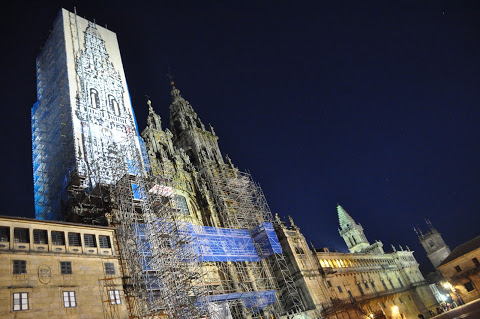
Greg Daly
Chris and Miriam kept me a seat for the pilgrim Mass at noon, and as I spotted the others filing in I noticed plenty of other familiar faces dotted through the crowd: Paul from Colorado who’d had dinner with me when I was shivering in Nájere, Sam from Switzerland who’d walked from Geneva, Eva from Austria, Louise from Quebec, the Lutheran minister who’d sprained her ankle crossing the Pyrenees, and so many others whose names I’d never even known. It was almost impossible to hold back tears throughout the Mass, and I gave up trying at the end, as we stared, mesmerized, as the botofumeiro, Santiago’s famous giant thurible, swung back and forth above our heads filling the cathedral with the smell and smoke of incense.
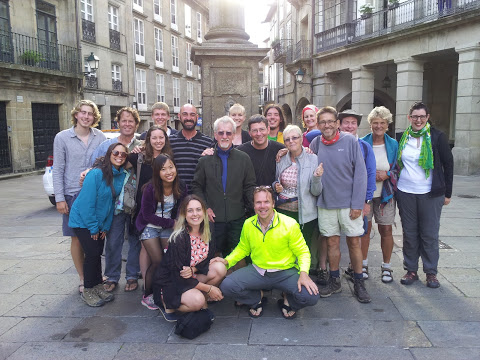
Greg Daly
The next two days were like a reunion party. The following day at Mass I met three of the American students who I’d spotted saying the office by the roadside at Roncesvalles weeks earlier, as well as John and Trish, New Zealanders who I’d met after Orisson as they’d turned back in the face of snow at the fourteen-kilometre point. The longer I stayed in town, the more people who I knew arrived.
I spent the morning of my third day in Santiago lighting candles and saying promised prayers in the cathedral, hugging the statue of St. James as pilgrims do, and visiting the tomb below the altar, wondering, as I’d last prayed before them in April, whether Leo XIII had had it right when he had ruled in favour of their authenticity in 1884. Not that it mattered in the end, I thought. The pilgrimage, the penance, and the prayers were real. That was enough.
A couple of hours later Leah, who’d walked with me all through my first week, phoned to say she’d just arrived, and so I hurried to meet her at the little bar next to my hostel at Praza Cervantes. We went out that night with Dave and Christa, fellow veterans of my first day of walking, listening to Galician music and sampling queimada, the local grappa-based "fire drink". While it was wonderful to be together, we didn’t stay out too long. I needed some sleep, after all, as the following day Sorren, Chris, Hannah and I were going to start walking again, this time wearing our weather-beaten scallop shells not as statements of intent, but as badges of achievement.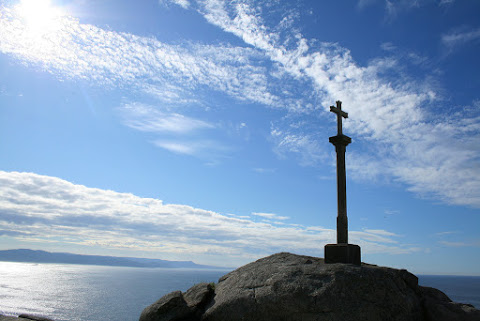
Javier T CC
Fisterra, the medieval end of the world, was just three days away.
